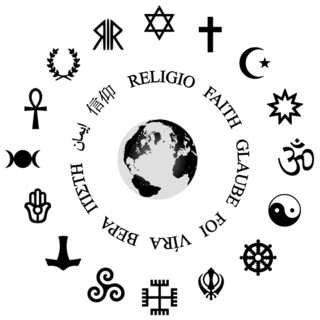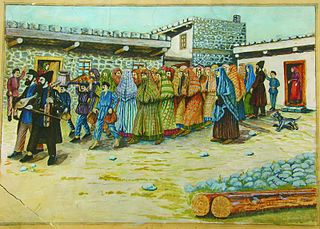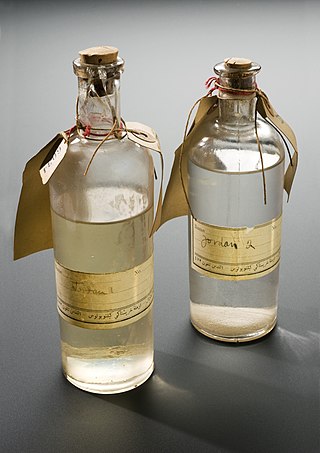
A priest is a religious leader authorized to perform the sacred rituals of a religion, especially as a mediatory agent between humans and one or more deities. They also have the authority or power to administer religious rites; in particular, rites of sacrifice to, and propitiation of, a deity or deities. Their office or position is the "priesthood", a term which also may apply to such persons collectively. A priest may have the duty to hear confessions periodically, give marriage counseling, provide prenuptial counseling, give spiritual direction, teach catechism, or visit those confined indoors, such as the sick in hospitals and nursing homes.

Prayer is an invocation or act that seeks to activate a rapport with an object of worship through deliberate communication. In the narrow sense, the term refers to an act of supplication or intercession directed towards a deity or a deified ancestor. More generally, prayer can also have the purpose of thanksgiving or praise, and in comparative religion is closely associated with more abstract forms of meditation and with charms or spells.

The following outline is provided as an overview of and topical guide to religion:

Mass is the main Eucharistic liturgical service in many forms of Western Christianity. The term Mass is commonly used in the Catholic Church, Western Rite Orthodoxy, Old Catholicism, and Independent Catholicism. The term is also used in some Lutheran churches, as well as in some Anglican churches, and on rare occasion by other Protestant churches.

Confession, in many religions, is the acknowledgment of sinful thoughts and actions. This may occur directly to a god or to fellow people.

A benediction is a short invocation for divine help, blessing and guidance, usually at the end of worship service. It can also refer to a specific Christian religious service including the exposition of the eucharistic host in the monstrance and the blessing of the people with it.

Ritual purification is a ritual prescribed by a religion through which a person is considered to be freed of uncleanliness, especially prior to the worship of a deity, and ritual purity is a state of ritual cleanliness. Ritual purification may also apply to objects and places. Ritual uncleanliness is not identical with ordinary physical impurity, such as dirt stains; nevertheless, body fluids are generally considered ritually unclean.

In religion, a blessing is the impartation of something with grace, holiness, spiritual redemption, or divine will.

Making the sign of the cross, or blessing oneself or crossing oneself, is a ritual blessing made by members of some branches of Christianity. This blessing is made by the tracing of an upright cross or Greek cross across the body with the right hand, often accompanied by spoken or mental recitation of the Trinitarian formula: "In the name of the Father, and of the Son, and of the Holy Spirit. Amen."

The Anglican Use, also known as Divine Worship, is a use of the Roman Rite celebrated by the personal ordinariates, originally created for former Anglicans who converted to Catholicism while wishing to maintain "aspects of the Anglican patrimony that are of particular value" and includes former Methodist converts to Catholicism who wish to retain aspects of Anglican and Methodist heritage, liturgy, and tradition. Its most common occurrence is within parishes of the personal ordinariates which were erected in 2009. Upon the promulgation of Divine Worship: The Missal, the term "Anglican Use" was replaced by "Divine Worship" in the liturgical books and complementary norms, though "Anglican Use" is still used to describe these liturgies as they existed from the papacy of John Paul II to present.

Holy water is water that has been blessed by a member of the clergy or a religious figure, or derived from a well or spring considered holy. The use for cleansing prior to a baptism and spiritual cleansing is common in several religions, from Christianity to Sikhism. The use of holy water as a sacramental for protection against evil is common among Lutherans, Anglicans, Roman Catholics, and Eastern Christians.
Litany, in Christian worship and some forms of Jewish worship, is a form of prayer used in services and processions, and consisting of a number of petitions. The word comes through Latin litania from Ancient Greek λιτανεία (litaneía), which in turn comes from λιτή (litḗ), meaning "prayer, supplication".

The Epiphany season, also known as Epiphanytide or the time of Sundays after Epiphany, is a liturgical period, celebrated by many Christian Churches, which immediately follows the Christmas season. It begins on Epiphany Day, and ends at various points as defined by those denominations. The typical liturgical color for the day of Epiphany is white, and the typical color for Epiphany season is green.
A spiritual practice or spiritual discipline is the regular or full-time performance of actions and activities undertaken for the purpose of inducing spiritual experiences and cultivating spiritual development. A common metaphor used in the spiritual traditions of the world's great religions is that of walking a path. Therefore, a spiritual practice moves a person along a path towards a goal. The goal is variously referred to as salvation, liberation or union. A person who walks such a path is sometimes referred to as a wayfarer or a pilgrim.

In Christian tradition the churching of women, also known as thanksgiving for the birth or adoption of a child, is the ceremony wherein a blessing is given to mothers after recovery from childbirth. The ceremony includes thanksgiving for the woman's survival of childbirth, and is performed even when the child is stillborn, or has died unbaptized.

Abhisheka is a religious rite or method of prayer in which a devotee pours a liquid offering on an image or murti of a deity. This is common to religions such as Hinduism, Buddhism and Jainism.
Religious use of incense has its origins in antiquity. The burned incense may be intended as a symbolic or sacrificial offering to various deities or spirits, or to serve as an aid in prayer.

A liturgical book, or service book, is a book published by the authority of a church body that contains the text and directions for the liturgy of its official religious services.

Around the World in 80 Faiths is a British television series which was first broadcast by the BBC on 2 January 2009. The series was presented by Anglican vicar Pete Owen-Jones, who was researching the various faiths from around the world.
















